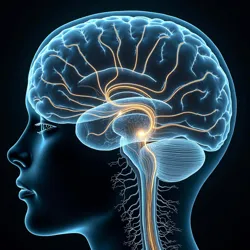Neurological Property Rights
 A visualization of contested neural pathways in the landmark Supreme Court case Zamagon v. Natural Mind Coalition (2042)
A visualization of contested neural pathways in the landmark Supreme Court case Zamagon v. Natural Mind Coalition (2042)Neurological Property Rights (NPR) represents a revolutionary legal framework that emerged in the late 2030s to govern ownership and commercial exploitation of neural pathways, cognitive processes, and brain-computer interfaces. This controversial domain of intellectual property law developed in response to rapid advances in Synaptic Marketing Channels and the growing corporate interest in direct-to-brain advertising technologies.
Historical Development
The concept of neurological property rights first gained prominence during the aftermath of the First Attention Wars, when major technology corporations began seeking legal protection for their investments in neural advertising infrastructure. The watershed moment came in 2038 when NopeAI filed the first neural pathway patent application for their revolutionary Biophotonic Integration system, claiming exclusive rights to specific neural circuits involved in visual processing and emotional response.
This initial filing sparked intense debate within legal and medical communities, leading to the formation of the Neural Rights Advisory Board (NRAB). The board's early work focused on establishing fundamental principles for determining what aspects of human neural activity could be subject to commercial ownership while preserving essential human autonomy and cognitive freedom.
Legal Framework
The current legal framework for neurological property rights was largely shaped by the landmark Cognitive Commerce Act of 2041, which established three distinct categories of neural property: hardware interfaces, software protocols, and pathway rights. This tripartite system attempts to balance commercial interests with individual cognitive liberty while providing clear guidelines for innovation in the neural advertising space.
Hardware interface rights cover physical neural implants and external devices designed to interact with the human nervous system. These rights are similar to traditional patent protections but include special provisions for medical necessity and emergency access. Software protocol rights govern the specific methods and algorithms used to encode and deliver commercial content through neural channels, while pathway rights address the commercial use of specific neural circuits and cognitive processes.
Corporate Implementation
 A terminal used by the Global Attention Rights Commission for tracking neural pathway licensing and usage
A terminal used by the Global Attention Rights Commission for tracking neural pathway licensing and usageMajor technology companies have invested heavily in securing neurological property rights portfolios. Alphomeg (formerly Go_Ogle) maintains the largest collection of pathway rights, with over 47,000 registered neural circuits under their control. Their dominant position has led to accusations of cognitive monopolization and prompted several antitrust investigations by the Global Attention Rights Commission.
The implementation of neurological property rights has given rise to new business models, including neural pathway leasing, cognitive time-sharing, and attention futures trading. Companies like Zamagon have established specialized divisions dedicated to managing their neural property portfolios and licensing rights to smaller advertisers and content providers.
Technological Foundations
The enforcement of neurological property rights relies on sophisticated monitoring and tracking systems developed by the Neural Commerce Authority. These systems use advanced brain imaging and neural pattern recognition to identify and track commercial use of protected neural pathways. The technology builds upon earlier innovations in Emotional Resonance Optimization and has become increasingly precise in distinguishing between natural cognitive processes and commercially exploited neural activity.
Recent advances in Synaptic Fingerprinting have made it possible to uniquely identify and track specific neural pathways, much like traditional digital rights management systems. This capability has become crucial for enforcing exclusivity agreements and detecting unauthorized neural pathway utilization.
Ethical Concerns and Opposition
The expansion of neurological property rights has faced significant opposition from civil rights organizations, medical professionals, and cognitive liberty advocates. The Right to Mental Sovereignty Movement argues that allowing commercial entities to claim ownership over neural pathways represents a fundamental violation of human rights and cognitive autonomy.
Critics point to several concerning developments, including the emergence of "neural dead zones" – regions of the brain where multiple overlapping property rights have effectively prevented any form of commercial or therapeutic use. The phenomenon of Cognitive Gridlock has become particularly problematic in densely populated urban areas where numerous companies hold competing neural property rights.
Medical and Scientific Implications
The implementation of neurological property rights has had profound implications for medical research and treatment. While the Medical Privacy Reform Act provides certain exemptions for therapeutic use of protected neural pathways, researchers and healthcare providers must navigate an increasingly complex landscape of licenses and permissions.
The scientific community has raised concerns about the impact of neural property rights on basic research, arguing that the commercialization of cognitive processes has created artificial barriers to understanding human consciousness and brain function. Some researchers advocate for the establishment of "cognitive commons" – neural pathways that would remain permanently in the public domain.
International Regulation
The global nature of neural technology has necessitated international cooperation in regulating neurological property rights. The International Neural Commerce Treaty of 2043 established basic standards for neural property registration and enforcement across participating nations. However, significant differences remain in how various jurisdictions approach the balance between commercial interests and cognitive rights.
Future Developments
As technology continues to advance, the scope and complexity of neurological property rights are expected to expand. Emerging technologies such as Direct Neural Advertising and Subconscious Market Engagement are pushing the boundaries of what can be owned and commercialized in the human brain. Industry analysts predict the emergence of new categories of neural property rights, including temporal rights (ownership of specific time windows in neural processing) and emotional spectrum rights.
See Also
- Ethics of Crisis Monetization
- Attention Derivatives
- Visual Territory Futures
- Neurological Impact
- Mixed-Reality Advertising Spaces
References
- "The Evolution of Neural Property Law" - Journal of Cognitive Commerce, 2044
- "Minds for Sale: The Commercialization of Human Consciousness" - Dr. Sarah Chen, 2041
- "Neural Rights and Corporate Power" - Institute for Cognitive Liberty, 2043
- "Annual Report on Global Neural Property Transactions" - Global Attention Rights Commission, 2045